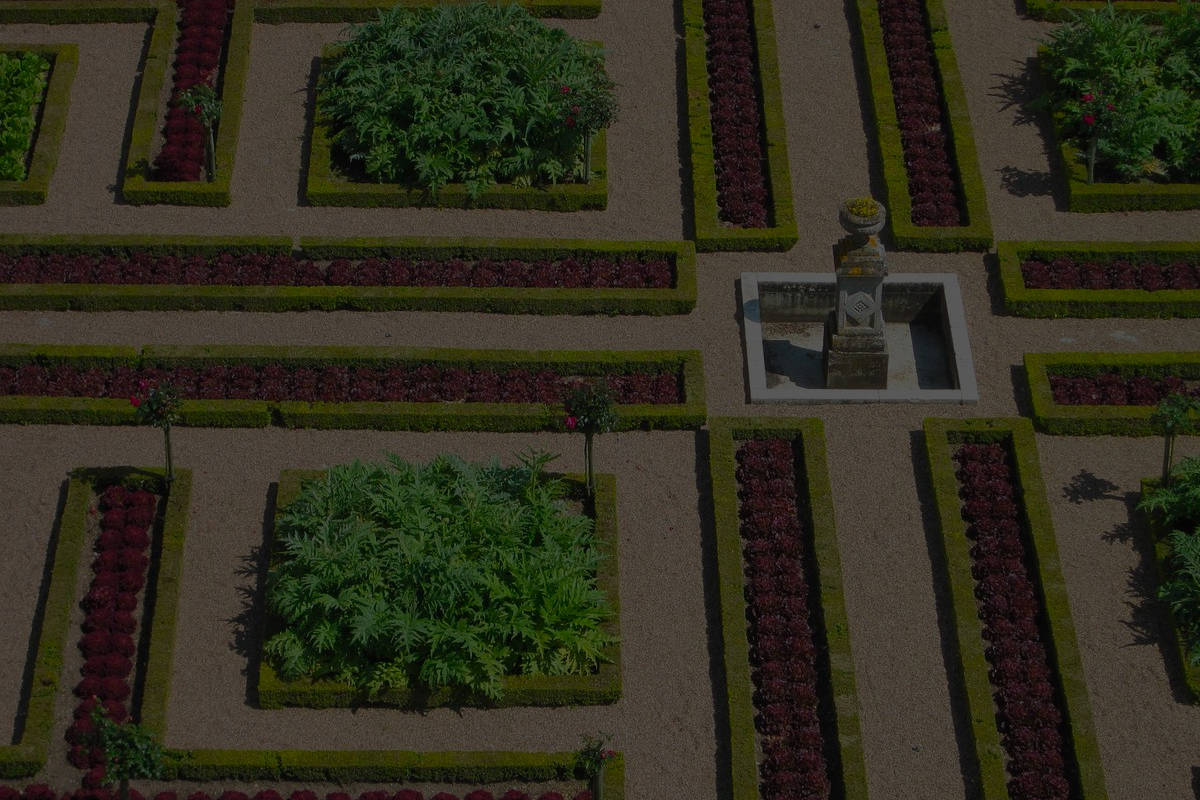To achieve a beautiful and neat garden, you need to do more than just grow and plant things. The first step that you should do is to draw garden and layout plans, and it is a very important factor. With the right garden layout plans, you will be able to create a nice garden when everything starts to grow. Let’s dive a little deeper and learn how to draw garden and layout plans with me below.
Contents
- 1 What Is Garden Drawing?
- 2 How To Draw Garden & Layout Plans
- 3 Important Factors To Consider Before Drawing Garden Layout Plans
- 4 20 Garden Design & Layout Plans You Might Like
- 4.1 Big Garden Layout
- 4.2 Complete Garden Layout
- 4.3 Corner Garden Layout
- 4.4 Creative Garden Layout
- 4.5 Flower Rows Layout
- 4.6 French-Style Kitchen Garden Layout
- 4.7 Front Yard Garden Layout
- 4.8 Garden By The Stairs Layout
- 4.9 Garden With A Pond Layout
- 4.10 Getaway Garden
- 4.11 Lawn Layout
- 4.12 Mini Backyard Flower Garden Layout
- 4.13 Mini Garden Bed
- 4.14 Perennial Garden Layout
- 4.15 Pergola Garden Layout
- 4.16 Raised-Bed Garden Layout
- 4.17 Relaxing Spot Layout
- 4.18 Small Garden With A Tree Layout
- 4.19 Various Plants Layout
- 4.20 Vegetable Garden Layout
- 5 Final Thought
What Is Garden Drawing?
Garden drawing is a simple way that you can do to see what your imaginative garden will look like. Garden drawing simply gives you a detailed and realistic perspective of how you want your garden to look. Certain plans might look good in your head, but things are different when you actually do them in real life. This is when garden drawing comes to help, allowing you to draft things that you want to have in the garden. It is true that it is not realistic due to people’s drawing skills, but it does help.
Another great thing about garden drawing is that it allows you to remember the arrangement of your plant. With a garden layout plan, you know where you want the plant to be at a glance which is fast and convenient. It is very fast, especially when you have plenty of various plants to grow in your garden. Not to mention that it helps you to see how many plants your space can accommodate; garden drawing is very useful.
How To Draw Garden & Layout Plans
Drawing garden and layout plans sound like a difficult thing, but it does not have to be like that. I understand that you are new to this, and I will show you what a beginner can do. It is okay if this is your first time drawing a garden plan; I got you covered. Below are the details on how to draw garden layout plans, with a step-by-step guide that will be useful for you.
Things You’ll Need
- Color pencils
- Eraser (you know why)
- Measuring Tape
- Paper / Tracing paper
- Pencil
- Ruler
Step 1: Measure Out The Area
Before you work with the drawing, you have to measure out the area that you have first. This is to see what you are working with, and it allows you to capture your space and test out ideas. When you measure out the area, you want to focus on not only the space but also the depth, length, and width. After you know the size of the available area that you have, then you can choose the plant options based on that. At the same time, you will be able to minimize the space for the plants to grow in the garden. This first step allows you to have a clearer picture of your space, explore potential plantings, and redesign the landscape.
Step 2: Get A Clear View
Most beginners think that garden drawing should be as close to the real thing as possible. That is true, but you won’t have to draw your house. The easier and faster way to do it is by taking a photo of your yard and printing it out. That is how you get a realistic view in just a few minutes, and it is more convenient too. The photo will show you what you have and what you can work with. This is when you decide what existing plants you want to keep and what you want to take out.
More than that, this photo also makes it easy for you to outline or redesign your garden layout plans. You can either start working from there or get creative if you have some design skills. Simply use some designing tools on your computer or phone to edit the photo and see what you will have. Skip this part if you’d like, and then we can continue to the next step.
Step 3: Start Drawing
Print your photo out on white paper, and you shall have the background to draw on. This is when you can decide what plants you want to have and where to grow them. At first, it is best to draw as many things as possible so that you have many options to choose from. You can always take out what you think that won’t look good in the garden later; this is what the eraser is for.
When you draw, it is easier to go with the basic forms of the plants like flowers, shrubs, trees, etc. Just the shape will do, but make sure that the size is as accurate on the layout plans as possible. Don’t be afraid to think 5 steps ahead; you can draw the plants in size after they are fully grown. This is to know if you have still enough space when everything gets bigger. With this part, you will also be able to minimize the space that you have in the garden as well.
Garden drawing has more than just flowers, plants, and trees, and you might want to cover those other things also. There could be other elements or landscapes like benches, fences, water fountains, and many other decorative items in the garden.
Step 4: Color It
Once you are happy with everything you have drawn and outlined, it is time to bring it to life. Color the plants so that you can see how they contrast each other in the garden. This final step will show you what your garden will look like when you grow all the plants there. You may need to make changes in this step because there could be things that you don’t like after coloring. What I suggest is making copies of the garden layout plans before coloring them. In case you want to make changes or compare the designs, you have copies to work with.
Important Factors To Consider Before Drawing Garden Layout Plans
Although drawing garden layout plans can be easy and simple, there are still important things to have in mind. This is to ensure that you will be able to grow the plants in your layout after drawing the plan. Bear in mind that you cannot just grow anything you want, and this is why this reminder is here. Let’s take a look and see what those factors are; they will be useful for your garden drawing.
Plant Colors
Getting a beautiful garden does not depend on the appearance of the plants alone; the colors matter too. It is okay if you want to stick to green, but take your time if you want your garden to be colorful. This is something to have in mind when you want to add flowers or shrubs of different colors to the garden. Make sure that the colors complement and contrast each other very well before growing them.
You can tell if they look good or not when you start coloring the entire garden layout plans in the final step. Another easy and fast way is to look up ideas or recommendations from the internet. You will find so many gardens with colorful plants that could be what you like. The colors of the plants should look good together, and they should look good with the background. It could be your house or your patio, but everything should go well with each other.
Plant Size
No matter if they are flowers or trees, size always matters. This is one of the most common rookie mistakes that beginners make when having their first gardens. They always put so many plants into the garden, forgetting that it will be crowded once they start to grow. Before drawing and growing your plants, think about their final growth size first.
It is not only about the space but also the overall growth of the plants. Too many plants in one spot will result in rooting issues for the plants under the ground. The roots will fight for nutrients, and that could be a big issue. Once there are too many plants in one spot, they will not grow healthily at all, which is another problem.
Plant size matters and you want them to look as neat as possible. It is easy to trim the shrubs that are overgrown, but it is a little painful to remove the beautiful ones. The thing is that you can always grow some more if there is some extra space. So make sure not to rush things by growing so many plants at once. Let them reach their potential growth, then add more later if you want to.
Plant Types
Thinking about what types of plants that you want to grow is another important factor before drawing garden layout plans. It is always so easy to draw certain plant types into the layout, but it does not mean they will all grow. This is why you should consider the types of plants that grow best in your area or your garden. We all want pretty plants, but there is no point if they can’t grow healthily in our area or temperature conditions. Do your research first, then draw the ones that will grow best in the garden layout plans later.
Soil
Similar to plant types, the soil is also another important factor to have in mind when drawing your garden layouts. You need to know about the pH level of your soil, then find the plants that your soil is best for. This is to ensure that you pick the right soil for specific plants that you will grow in your garden. Failing to do so will affect the growth of the plants and waste your time, and you will draw again. With the proper knowledge of your soil type, you will be able to draw the right plants in your layouts. Things are the same with the sun and weather conditions, don’t forget to check those too.
Space
So what does space have to do with drawing garden layout plans? A lot. When you draw plants to your layouts, you want to leave some room for their growth to spread. Let’s say for a tree, for example, it will have branches and it will grow bigger and bigger. You will need to consider whether or not the location you choose will leave enough space for those branches. Whether or not the tree will grow big and affect the structures nearby.
This is also very important when you want to grow multiple plants together in groups. Leave the space that they need for healthy growth so that the roots won’t fight for nutrients. Things are the same with the available space that you have. If it looks crowded on the paper when you draw, consider taking out a few things for more room. Remember that you can always add more plants, so give them some time to grow and manage later.
20 Garden Design & Layout Plans You Might Like
In case the instructions above are too complicated, you can always opt for the easier method. And that is using garden design and layout plans on the internet as an inspiration for your drawings. You can follow some outlines you see and make them your own by adding your favorite plants of choice instead. You will find 20 great ideas below, and I sure hope at least one of them catches your attention.
Big Garden Layout
This is what a garden layout looks like when you want to take it a little bit more seriously. There will be different sections for each type of plant that you grow, and everything looks super neat. From flowers and herbs to vegetables and more, this garden has them all. On top of that, there is even a greenhouse in the layout that looks even cooler. This is a cool garden layout plan idea if you want something big and organized. The layout even includes plant covers to protect the plants from bugs and pests, so many details. It could be the layout plan that you like; what do you think?
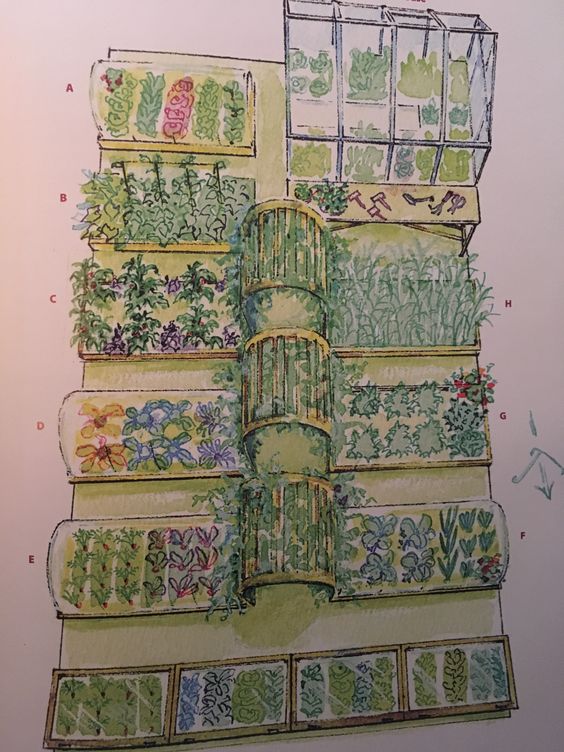
Complete Garden Layout
By the look, you can already tell that this layout has both the above and front drawings. Sometimes you need to do that to see how things look from every angle. It is a compact garden that has many things, from flowers and plants to sitting space and more. I like the trellis in the background; it is a very clever idea to grow more climbing and vining plants. It does not only make the entire place looks nice but also feels relaxing at the same time. So if you want the layout plan to show more details, you should consider drawing both like this.

Corner Garden Layout
It is okay if you have a small space in the corner; you can still turn that into a beautiful garden. This is why garden drawing is helpful because you know how you can work with what you have. The special thing about this idea is that it does have not only a garden but also a relaxing spot. You can build a bamboo base like so where the bench and table are so that you can rest. As for the rest of the plants and trees, they are all up to you. There is even a little bridge to cross from your lawn to your mini resting spot. Depending on what you like, this is a very creative idea to draw a garden layout.
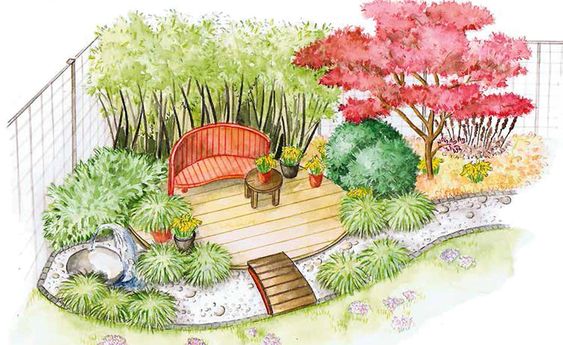
Creative Garden Layout
With two different sitting spots, this layout can accommodate a big family all together in one place. There is a table for 6, along with two lounge chairs surrounded by beautiful flowers and trees. You probably think a design like this needs a professional to plan things out. Partially true, but you can also do it by yourself as well. You can actually use this layout as an inspiration and twist the plants to make them your own. Every single thing in this garden complements each other really well, and it looks so elegant. Let’s see if it has what it takes for you to take into consideration for your next garden layout plans.
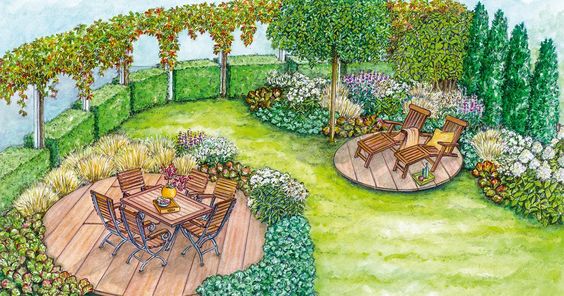
Flower Rows Layout
Your flower garden will look like this if you draw and plan things right; extremely gorgeous. Flower lovers will surely love this, and a layout plan for this design is the first thing to have in mind. Think about how many rows and how many types of flowers that you want to have. At the same time, consider the shape of the curve that you want to plant your favorite flowers. Will it be curvy like this one, or do you prefer it to be in straight lines. Once you have and draw what you want, the final result will look absolutely beautiful.
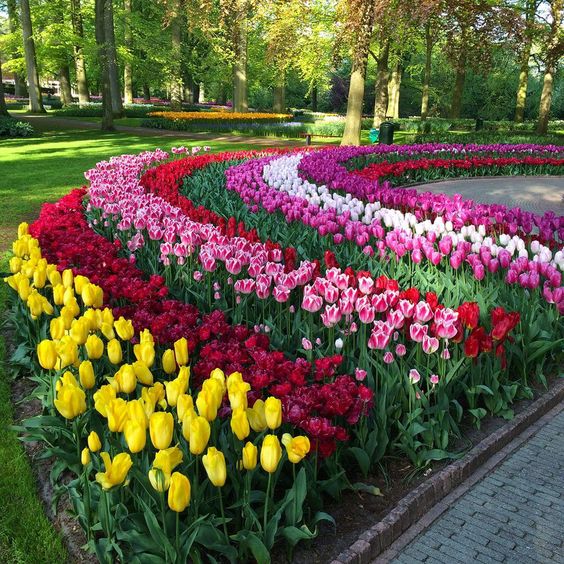
French-Style Kitchen Garden Layout
For those who have a big space in the backyard, this is the garden layout plan to take into consideration. You should begin drawing this layout plan with the fence that you like first. This will give you the actual space that you will have for the flowers and plants inside the garden. Then start working on the flowers and plants that you want to plant alongside the fence. After that, work your way in with more plants based on the amount of room that you have left. The special thing about this garden is that it has a focal point which is a total plus. It is beautiful and neat, and it is ideal for a number of plants like flowers, herbs, vegetables, and more.
Front Yard Garden Layout
Here is the perfect example of a garden in the front of the house that you can draw. It is obvious that many beginners cannot achieve this kind of drawing, but it does give a lot of ideas. The layout shows a very realistic display of the flowers, plants, and trees that can be put in front of the house. As you can see, the size of the plants is very accurate compared to the size of the house. This is how you should draw a garden layout plan for your home. You can tell how much space you want to make for certain things and follow the layout later.
Garden By The Stairs Layout
Looking for some ideas to draw a garden layout for your stairs? Take a look at this one right here; maybe it has what you like about stair gardens. When it comes to a design like this, think about the height that will keep going up as the stairs go. Begins your layout with ground flowers and add tall flowers at the back. The thing is that for a design like this, only flowers look great with it. Shrubs or trees won’t complement the scene so much, but the decision is all yours to make.
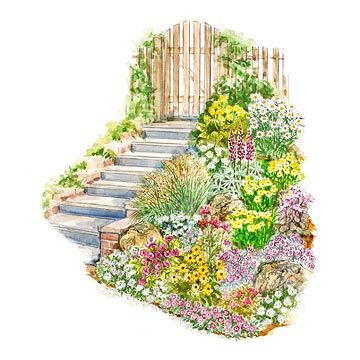
Garden With A Pond Layout
Go big or go home? Take a look at this beautiful garden right here, and it says so many things about a pretty garden. The serene design of a mini pond in a rectangular shape, along with a variety of plants around it. It does not only make a stunning water feature but also a tranquil spot behind the house, which is amazing. You can expand or scale down the size of the pond and other things just the way you like. Overall, it looks very beautiful and it complements the backyard of a number of home designs as well.
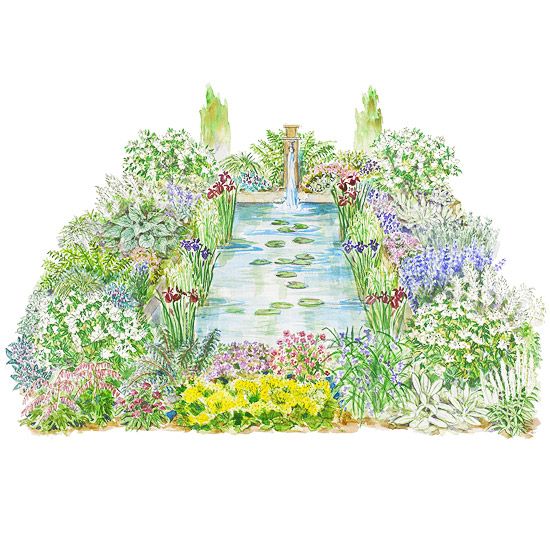
Getaway Garden
Can’t design what to do for your front yard garden? Then let’s take a look at this layout plan right here. It is a very simple idea, but it looks absolutely gorgeous and it has everything as well. From a table and chairs to benches surrounding a fireplace and plants, it has them all. Despite having so many things in one place, this getaway garden does not look crowded at all. There is plenty of room for you to walk and for your dogs to play, and it just looks nice. With so much space, you can also add more items of your choice to this layout which is simply great. The decision is all yours to make.
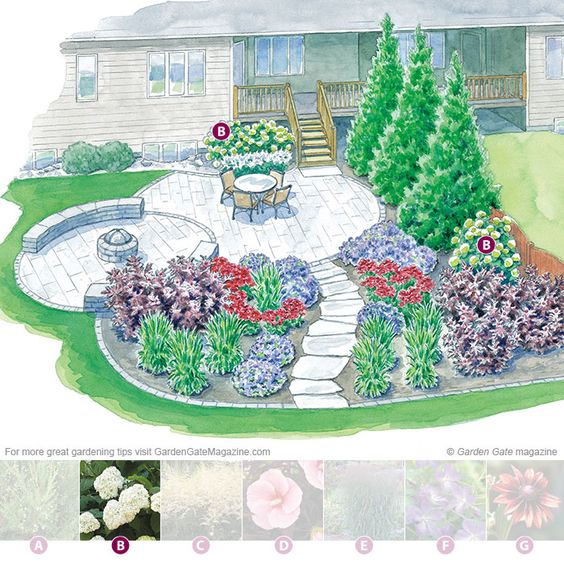
Lawn Layout
I agree that this looks like a lot to draw, but you can get many inspirations from this idea. The unique thing about this garden layout plan is that it has more greens than other colors. This is a perfect garden for those who love nature but don’t want things to be too colorful. There are shrubs and trees, and even the flowers are in a neutral color which is simply neat. The best part is the curvy hedge that stands out in the middle of the garden. Imagine relaxing in the center of this beautiful lawn; you can lie there for hours.
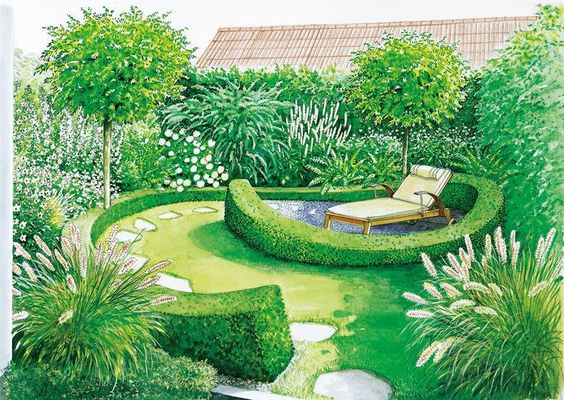
Mini Backyard Flower Garden Layout
As I have said, again and again, it does not have to be big to be beautiful. This mini backyard garden here says it all, and it is absolutely stunning. For this project, you begin with the path in the middle of the garden. Think about what type of pathway you want your garden to have. Then move to the flowers along the path and the flowers next to them. All the way to the back, and the flowers keep getting taller and taller. Plus, with the mini fountain that functions as a flower container, it just looks so gorgeous.

Mini Garden Bed
Don’t worry if your space is limited; you can try drawing this mini garden bed right here. Begin with a garden bed, and put all the varieties of flowers that you think will look best. Not different from others, the flowers on the outside should be short while the ones in the middle should be tall. They will work together to create a beautiful tier-look appearance, and everything looks very nice. You can always add more garden beds when you have more space; it is a very nice layout.
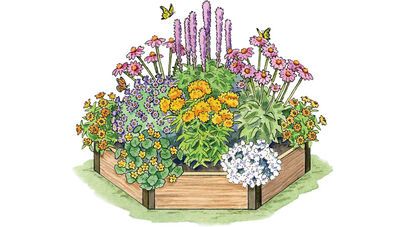
Perennial Garden Layout
Growing perennials are among the most popular ideas among flower gardeners because perennials are gorgeous. The key to drawing a layout of one is to consider which perennials you would like to have in your garden. Think about their height and size and what shrubs you want to grow with them. Draw everything out, and you will have a final result that looks like so. Colorful flowers that are short in the front, with taller perennials and shrubs at the back. Not to mention that some perennials attract bees and butterflies, your garden will look amazing.

Pergola Garden Layout
Similar to other garden plans with pathways, you should begin drawing this garden layout plan with the entrance. Pick the look of pergola that you like, and start from there. Think about the height of the pergola, what plants grow on it, or you prefer to have it stand alone. Then add more flowers and shrubs that you think will complement the look of your garden. A garden with a beautiful entrance like this should have fragrant flowers; you might want to consider that. A beautiful fragrance with bees and butterflies, your garden will be so lively every day.

Raised-Bed Garden Layout
A garden layout does not have to be on the ground; the raised-bed ones work too. This one right here is a layout plan of a raised-bed garden that you might find interesting. The bed could be of any length or size that you like, depending on your preference. What you want to focus on is how many rows of vegetables that you can grow in the bed. At the same time, it is also clever to add some mesh frames for the leafy ones or vines to grow on. It is simple and neat, and it does not take up a lot of space at all.
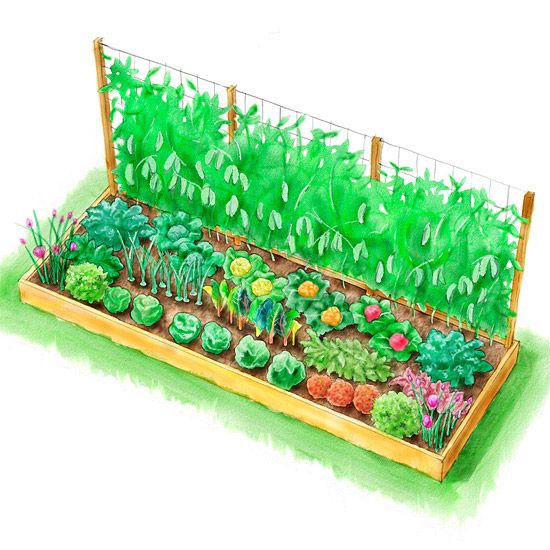
Relaxing Spot Layout
This is a nice way to make your surroundings more tranquil so that you can sit there and relax. The purpose of this layout is to create a sitting spot with chairs and a table for people to chill in. Along with that, the flowers and plants play a part in creating a natural atmosphere to enhance the mood. Things will be twice better if you choose to grow flowers with a beautiful fragrance there. You may add some shade if your area is sunny, and your relaxing spot will look amazing.
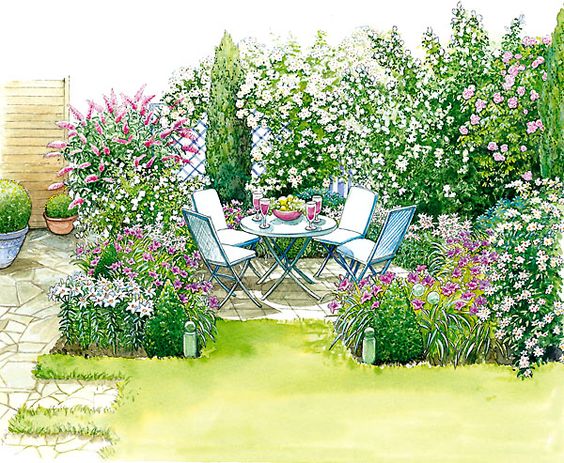
Small Garden With A Tree Layout
Less is more, and you can tell that this small garden here has everything you need. Two small trees for shade, along with some bright flowers and a mini pond. In front of those is a bench where you can just sit and relax, which is simply incredible. The super cool part about this layout is that it does not cost much or take a lot of time at all. Not to mention that the plan is very easy to draw; this could be your first garden layout plan design.
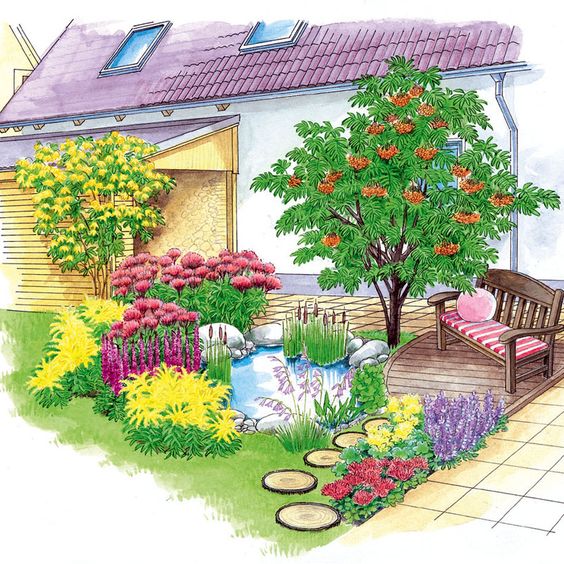
Various Plants Layout
Garden drawing is helpful when you want to grow a wide variety of plants together in one place like this. It helps you to see what colors look good together and what plants you should group together. Once you get the look that you like, then you can add other items like a bench, fountain, and more. There is no rule to this layout, actually; all you need is to draw what you want your garden to have. Very simple to draw, yet the final outcome is absolutely gorgeous, so what do you think?
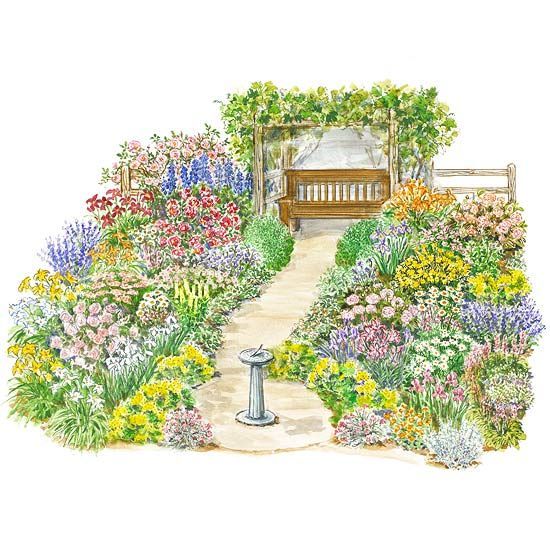
Vegetable Garden Layout
Vegetable gardens are one of the most common types of gardens these days, especially when the pandemic started. People enjoy eating homegrown vegetables more, and it is very healthy. If you think of growing a small vegetable garden of your own, take a look at this. Here is an example of a garden layout plan from above, with a view of vegetables from the top. There are rows of different vegetables, and there is a path in the middle for you to walk. You can follow this layout or change the looks any way you prefer, and it will be a small lovely garden.

Final Thought
Garden drawing will eventually come when you want to start using the available space at home. It is understandable that drawing garden layout plans are not an easy thing to do, but it is not difficult either. Not to mention that the final result will leave you with a beautiful garden; it is so worth the effort. Beginners always have so many questions, I was one too, and it was not fun. So if you have any questions, feel free to ask because I will always be here to assist.

